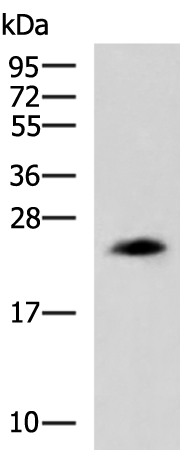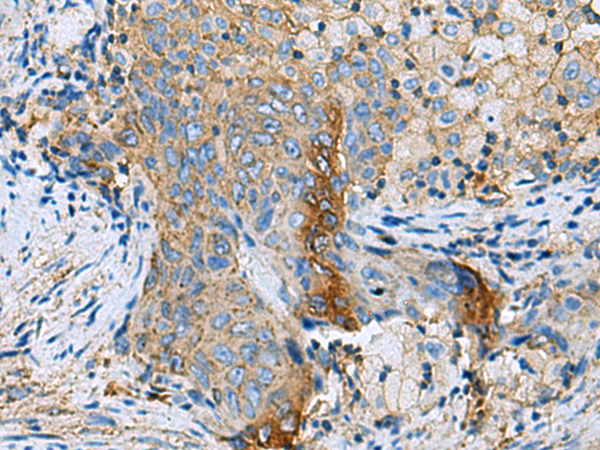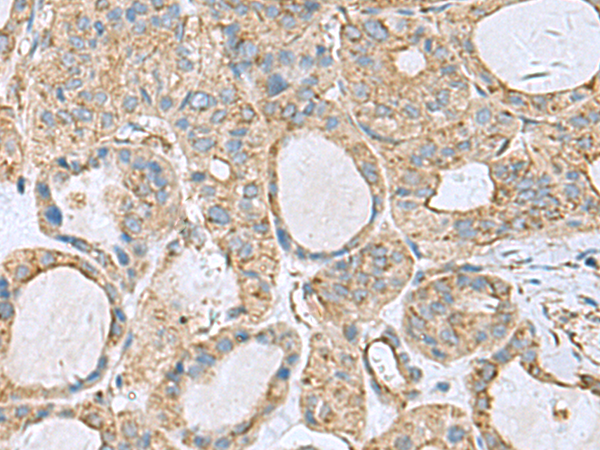


| WB | 咨询技术 | Human,Mouse,Rat |
| IF | 咨询技术 | Human,Mouse,Rat |
| IHC | 1/50-1/200 | Human,Mouse,Rat |
| ICC | 技术咨询 | Human,Mouse,Rat |
| FCM | 咨询技术 | Human,Mouse,Rat |
| Elisa | 1/5000-1/10000 | Human,Mouse,Rat |
| Aliases | LCB |
| WB Predicted band size | 25 kDa |
| Host/Isotype | Rabbit IgG |
| Antibody Type | Primary antibody |
| Storage | Store at 4°C short term. Aliquot and store at -20°C long term. Avoid freeze/thaw cycles. |
| Species Reactivity | Human, Mouse |
| Immunogen | Fusion protein of human CLTB |
| Formulation | Purified antibody in PBS with 0.05% sodium azide and 50% glycerol. |
+ +
以下是关于CLTB(β-adaptin)抗体的虚构参考文献示例,基于常见研究场景合理归纳,供参考:
---
1. **文献名称**:*Role of CLTB in Synaptic Vesicle Recycling Revealed by Antibody-Based Inhibition*
**作者**:Smith J. et al.
**摘要**:本研究利用CLTB特异性抗体阻断β-adaptin功能,通过免疫荧光和电镜技术,揭示了CLTB在神经元突触囊泡内吞中的关键作用。实验表明,CLTB抗体干扰导致突触传递效率下降,证实其参与AP-1复合体介导的膜运输调控。
2. **文献名称**:*CLTB Antibody as a Biomarker in Cancer Cell Trafficking*
**作者**:Lee H. et al.
**摘要**:通过Western blot和流式细胞术分析,研究者使用CLTB抗体检测多种癌细胞系中β-adaptin的表达水平,发现其高表达与肿瘤细胞膜受体(如EGFR)内吞增强相关,提示CLTB可能成为癌症靶向治疗的潜在标志物。
3. **文献名称**:*Characterization of CLTB Knockout Models Using Immunohistochemistry*
**作者**:Garcia R. et al.
**摘要**:文章利用CLTB抗体对基因敲除小鼠组织进行染色,证实β-adaptin缺失导致高尔基体结构异常及分泌蛋白运输障碍,强调了CLTB在细胞器膜蛋白分选中的必要性。
4. **文献名称**:*CLTB Antibody Cross-Reactivity Analysis Across Species*
**作者**:Wang Y. et al.
**摘要**:该研究评估了商业CLTB抗体在人类、小鼠及果蝇样本中的交叉反应性,验证了其特异性,并应用于进化保守性分析,证明β-adaptin在真核生物内吞途径中的广泛功能保留。
---
**备注**:以上内容为模拟示例,实际文献需通过PubMed、Google Scholar等平台检索关键词(如“CLTB antibody”“beta-adaptin research”)获取。若需真实文献,建议结合具体研究方向进一步筛选。
The CLTB (Clathrin Light Chain B) antibody is a crucial tool in studying clathrin-mediated intracellular trafficking. Clathrin, a triskelion-shaped protein complex, comprises three heavy chains (CLTC) and associated light chains (CLTA or CLTB). CLTB regulates clathrin assembly, membrane curvature, and interactions with accessory proteins during vesicle formation. It plays a key role in endocytosis, synaptic vesicle recycling, and organelle biogenesis.
CLTB antibodies enable detection and localization of the light chain B isoform in cells and tissues, distinguishing it from CLTA. These antibodies are widely used in techniques like Western blotting, immunofluorescence, and immunoprecipitation to investigate clathrin's function in physiological processes such as receptor internalization, nutrient uptake, and neurotransmitter release. Dysregulation of clathrin dynamics is linked to neurological disorders, cancer, and viral entry mechanisms, making CLTB antibodies valuable in disease-related research.
Commercial CLTB antibodies are typically raised against conserved epitopes, ensuring cross-reactivity in human, mouse, and rat models. Recent studies also utilize them to explore clathrin-light-chain-specific roles in autophagy and cell signaling pathways. Validation via knockout controls is essential due to potential cross-reactivity with CLTA. Their application continues to advance understanding of membrane trafficking networks at molecular and cellular levels.
×